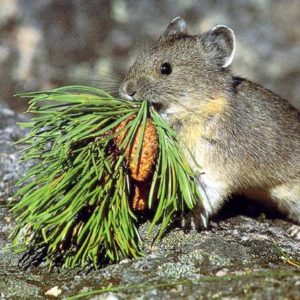 High up on a mountain, little furry animals run between rock crevices underneath the snow. They cheep to one another, emitting a high pitched call to send signals to their friends. After resting and conserving energy in their rounded bodies, these little mammals dip into their food stores, finally breaking into the dried grass, saved up from summer to give them the strength to make it through the winter. They spend their winters dreaming of running about and collecting wildflowers in the sun again.
High up on a mountain, little furry animals run between rock crevices underneath the snow. They cheep to one another, emitting a high pitched call to send signals to their friends. After resting and conserving energy in their rounded bodies, these little mammals dip into their food stores, finally breaking into the dried grass, saved up from summer to give them the strength to make it through the winter. They spend their winters dreaming of running about and collecting wildflowers in the sun again.
If you have ever hiked above 11,000 feet, you may have seen one of these creatures darting in and out of spaces between rocks. Perhaps you might notice that what you thought was a rock in the distance is actually a living being perched atop a boulder, or maybe you observed one’s home as I did – a pile of straw-like grasses a few inches from a pile of teeny tiny scat. This animal tends to “prance” around on the rocks, reminiscent of a tiny prince derived from its Latin name: Ochotona princeps. Princeps means leader, authority, or chief – easiest to remember as a prince.
The miniature animal I am describing is a pika. Commonly assumed to be a member of the rodent family, this little mammal is actually more closely related to a rabbit. Pikas, hares, and rabbits are all considered Lagomorphs, herbivorous mammals with a short or vestigial tail. Though the pika’s round ears, tiny body, and coloring may remind of us a mouse, this animal is not a rodent. Pika do not hibernate throughout the winter. They remain active beneath the snow, a rare thing for a mammal of this size. Because of this, they must stock up for winter. During the summer months, they will collect grasses, forbs, and wildflowers and form stacks of vegetation on sunny rocks. These piles are called haypiles or haystacks and are conceptually similar to beef jerky; meat and vegetation lasts longer when it is dry rather than fresh. By utilizing the sun and rocks as natural resources, the pika dries food that it will save for the winter. Haystacks are stashed between the rocks for a back-up food supply and can reach sizes as large as a bathtub! These mammals certainly prepare.
For animals small enough to fit in your hand – a mere six to eight inches – pikas have a fairly high survival rate. This is most likely because their homes are found in crevices in talus fields, a place most other mammals, and certainly predators, cannot reach. Despite the pika’s success evading predators, it is facing an even greater challenge: climate change. Pikas are delicate creatures, unable to regulate their body heat once the climate in which they live surpasses eighty degrees Fahrenheit. It takes only a few hours before the pika can no longer survive in this extreme heat and will perish from dehydration and overheating. Previously recorded as living in both the Sierra Nevada Mountains of California and various mountains throughout Colorado, the pika is now only listed by the U.S. Fish & Wildlife Service as existing in Colorado. It is not recorded as Endangered or even Threatened. With such strict temperature requirements, the pika’s lack of protection is somewhat concerning. These little fluff balls are rapidly losing habitat as summers become warmer and snow melts earlier, removing a layer of protection they rely upon in winter.
Consider yourself lucky if you are able to see a pika firsthand, and especially if you are nimble enough to snap a picture. You may hear one before you see it. Keep your ears open for their call and your eyes alert for their quick dashes between rocks. Enjoy these little puffs of fur while they’re active this summer!
Kira Koppel is a Naturalist and Sustainability Intern at Walking Mountains Science Center. She hopes to help others realize the connections between their lives and the natural environment around them, aiming to encourage both sustainable lifestyles and an appreciation of the amazing nature in our backyards.









